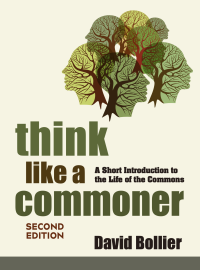Every two years, the universe of scholars who study the commons converge on some spot on the planet to present their research findings, argue about theoretical models and party-hardy. Just kidding about that last one, but it is hard to imagine a more interesting party than 600 people from 90 countries around the world.
I have encountered an Indian economist who has closely studied the role of women in improving the sustainability of forest commons in Nepal (Bina Agarwal), an Australian academic who has written about modern-day gleaning such as “dumpster diving” (James Arvanitakis), a British activist who helped pass a modern-day law to protect British common lands (Kate Ashbrook of the Open Spaces Society), an Indian-American who is studying how language shapes our ability to understand the commons (Vijaya Nagarajan), a Belgian historian of the European commons (Tine De Moor), among many others.

It is quite a pleasant shock to suddenly be around so many people who not only know what the commons is; they can get into some rather arcane and sophisticated arguments about it. The conference is skewed towards academics, however, which means that the policy and activist sensibility is somewhat muted. That’s too bad, but I hope it might change in the future.
There is also an emphatic focus on natural resource commons, with a very limited exploration of so-called “new commons,” by which the IASC academics mean commons that have arisen in unconventional realms such as the Internet. I find this too bad, because there is so much to be learned from digital commons, which are among the most robust commons out there. The phrase “new commons” is also vaguely off-putting because it privileges the natural resource commons so absolutely. Now I have an inkling of how Native Americans must have felt to have been “discovered.”
One of the more fascinating projects that I have learned about is the System of Rice Intensification, or SRI, in India. As described in a paper by Shambu Prasad, “Agriculture and the New Commons,” many Indian farmers are pioneering a new form of “agroecological innovation” by using the Internet to share their learning and innovations. SRI emerged outside of the scientific establishment as a way to produce higher rice yields through “knowledge swaraj" – swaraj meaning “self-rule.”
This is no small project because the opening up of Indian agriculture to unfettered market forces has been catastrophic for millions of Indian farmers. Some 200,000 have committed suicide over the past ten years; most of them are attributed to the intense, even insuperable financial pressures and to loss of their traditional practices and identities to market-driven agriculture.
Rather than adopt the farming practices of the conventional market and the knowledge paradigm of the scientific/government establishment, however, the SRI practitioners use indigenous varieties of crops and shun chemical pesticides and fertilizers. The whole enterprise is a vast social network of Internet-mediated participation that is aimed at learning how to eke out better yields on marginal plots of land. Some farmers even learn to “play with the monsoon” and its capricious ways to build soil health. The SRI knowledge commons has scientists, farmers and citizens all talking together on the same platforms, rather than the market-oriented “experts” declaring how agriculture should be pursued.
Since its introduction in 1999, SRI has been embraced in 40 countries as an “open source” system of rice farming. The Internet has accelerated the learning and innovation curve and has enabled a rich culture of learning to arise. SRI manuals developed by Indians are shared with farmers in Cuba and Sri Lanka, for example. By 2010, there were more than 400 members from 25 countries in an online SRI group.
Just one paper among scores presented at the International Association for the Study of Commons gathering. For more, check out the conference website.










Recent comments